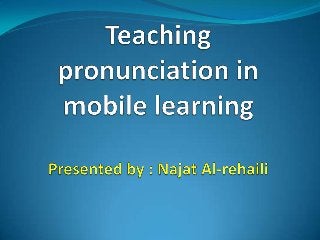
Teaching pronunciation in mobile learning
- 2. The second generation of mobile devices enable their users to access multimedia functions including listening and speaking ones. A good m- learning service should consist of speech facilities for transmitting voice. Having such facilities, the learners may download dictionaries on the PDA1 with sound functions so that they can learn the correct pronunciation of unfamiliar or new words to be able to fulfill their learning needs. Mobile devices with multimedia function give the learners the opportunity to record their own voice. Then, teachers are able to make a better assessment of the students' weaknesses in pronunciation.
- 3. This way, by enhancing various functions of the system like providing a dictionary for looking up unfamiliar words and their correct phonetic form, the pronunciation as well as speaking skills of the learners can be well improved. The speech aspect of mobile learning is as significant as textual aspect of it, since it enables learners to comfortably speak with a system recording their voice and allowing them to listen back to themselves. Then, they can compare their voice with an ideal pronunciation and make an improvement in this skill.
- 4. However, to develop our skills in pronunciation , we can use mobile device applications in some of the following ways: 1- Pronunciation guide : It is important for language learners to know how to pronounce a new word that they are not familiar with .
- 5. 2- Pronunciation correction : There is potential for computer assisted language learning applications to sample input from the learner and determine whether the pronunciation of key sounds (such as vowels or difficult consonants) are articulated in a near native-like manner.
- 6. 3-Pronunciation modeling: CALL applications could also potentially offer modeling of the spoken input as an average over time. This could determine patterns or common errors made. so the ability to personalize the learning application to an individual would be very useful.
- 7. 4- Conversational practice to assist fluency : We can use mobile devices to assist conversational practice. Mobile devices (particularly phones) are very much suited for this kind of interaction. They have a natural affordance for audio interaction as we primarily use phones to speak into and listen from. Therefore, there are excellent reasons for exploring this aspect for mobile language learning.
- 8. Bibliography 1- Mobile Devices For Language Learning: Multimedia Approaches By: Samuel R. H. Joseph 2- Mobile-Assisted Language Learning By: Tayebeh Mosavi Miangah1 and Amin Nezarat2